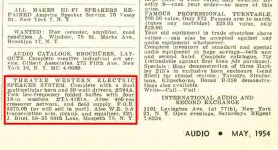When I was at Bell Labs (yes, the fancy lab in Murray Hill) late 60s, I found a couple in the hall outside a neighbouring lab door and took them home, with their OK. Can't recall ever firing up any. But I did want to examine the driver (but destroyed it in the process).
Edge-wound flat aluminum wire and quite a giant aluminum dome.
I think the basic math for horns is long known. No secrets.
Really stupid trying to vibrate a gas like air using vastly heavier mechanical assemblies. Sure path to distortion. A horn is a transformer which condenses the heavy air at the point where it touches the cone and so the gas weight comes closer to matching the assembly weight. Therefore it is potentially a correct method while all the other boxes are clumsy kluges and work-arounds.
Of course a smarter way is to vibrate the air using a gas (ionic drivers) or very light-weight diaphragms (like electrostatic, ahem, ahem). The benefits are plain to hear.
B.
Edge-wound flat aluminum wire and quite a giant aluminum dome.
I think the basic math for horns is long known. No secrets.
Really stupid trying to vibrate a gas like air using vastly heavier mechanical assemblies. Sure path to distortion. A horn is a transformer which condenses the heavy air at the point where it touches the cone and so the gas weight comes closer to matching the assembly weight. Therefore it is potentially a correct method while all the other boxes are clumsy kluges and work-arounds.
Of course a smarter way is to vibrate the air using a gas (ionic drivers) or very light-weight diaphragms (like electrostatic, ahem, ahem). The benefits are plain to hear.
B.
I had a look at that GIP Laboratory site. Although I would never buy any of those systems myself, even if I had the money, I must admit that the craftsmanship on their stuff seems to be very nice. It is always astonishing to see the meticulousness of some Japanese craftsmanship
It starts alreayd with products of daily use - as it is great fun to watch an experienced sushi chef doing his work calmly and exactly for instance.
Somewhere they mention the directivity of the system using the old Western Electric style horn: 30 x 25 degrees ! And I always thought my 60 x 50 degrees System was for selfish listeners ....
Regards
Charles
It starts alreayd with products of daily use - as it is great fun to watch an experienced sushi chef doing his work calmly and exactly for instance.
Somewhere they mention the directivity of the system using the old Western Electric style horn: 30 x 25 degrees ! And I always thought my 60 x 50 degrees System was for selfish listeners ....
Regards
Charles
There must be a misunderstanding. I didn't mean GPA (Great Plains Audio) who are the succsessor of Altec (and who seem to make fine products as well) but the Japanese guys mentioined in post 17:
GIP-555 / 555W
Regards
Charles
GIP-555 / 555W
Regards
Charles
Joe Roberts, representative of G.I.P. Laboratory / Silbatone Acoustics and WE aficionado:
"I can look you in the eye and say that the 594A is the BEST compression driver ever made. This was part of the second generation WE engineering coup, the Mirrophonic systems.
These are far more scarce than 555 drivers. They were only out for two years or so before WE abandoned the theater business. A truly cost no object driver. To buy the cobalt used in the pole piece and yoke costs a couple thousand bucks today. These mainly went into large fancy theaters.
594As went on multicells in proto VOTT type systems, 300hz LF cutoff. 18" field coil woofers in open back horn baffles. 86 or 91 model 300B amplifiers.
I saw an ad for used theater gear in the early 50s and a complete Mirrophonic model 2 system, possibly including the electronics, was listed for what the inflation calculator put at near a quarter million bucks!
No more efficient driver was ever made. Also, a mostly unknown feature of that driver is this: All midrange compression drivers exhibit a mass rolloff starting at about 5-6k. The rolloff on the 594 approaches the theoretical perfect maximum output and is controlled within 0.25 dB, so that when a simple 6dB peaking network is placed in the amplifier (one cap), the output is flat to 13k. An RCA engineer I know told me that they were adjusted for minimum group delay under this condition...in 1934!"
The WE 594-A / WE 26-A combo (image 1-3) was used in 1936 at the Tercentenary of Harvard University.
Dimensions:
99.5 x 94 x 59.2 cm, 130 lb. (39 3/16 x 37 x 23 5/16 in., 59 kg)
The loudspeaker is marked in several places "NDRC" and "An. Res.___LLB." This indicates that it was used by Leo L. Beranek in his Electro-Acoustic Laboratory during his classified research for the US Navy on mitigating sound in combat situations. The equipment was marked and the project was put on Harvard's books as "Anonymous Research by Leo L. Beranek" to keep it a secret. NDRC stands for National Defense Research Committe.
"I can look you in the eye and say that the 594A is the BEST compression driver ever made. This was part of the second generation WE engineering coup, the Mirrophonic systems.
These are far more scarce than 555 drivers. They were only out for two years or so before WE abandoned the theater business. A truly cost no object driver. To buy the cobalt used in the pole piece and yoke costs a couple thousand bucks today. These mainly went into large fancy theaters.
594As went on multicells in proto VOTT type systems, 300hz LF cutoff. 18" field coil woofers in open back horn baffles. 86 or 91 model 300B amplifiers.
I saw an ad for used theater gear in the early 50s and a complete Mirrophonic model 2 system, possibly including the electronics, was listed for what the inflation calculator put at near a quarter million bucks!
No more efficient driver was ever made. Also, a mostly unknown feature of that driver is this: All midrange compression drivers exhibit a mass rolloff starting at about 5-6k. The rolloff on the 594 approaches the theoretical perfect maximum output and is controlled within 0.25 dB, so that when a simple 6dB peaking network is placed in the amplifier (one cap), the output is flat to 13k. An RCA engineer I know told me that they were adjusted for minimum group delay under this condition...in 1934!"
The WE 594-A / WE 26-A combo (image 1-3) was used in 1936 at the Tercentenary of Harvard University.
Dimensions:
99.5 x 94 x 59.2 cm, 130 lb. (39 3/16 x 37 x 23 5/16 in., 59 kg)
The loudspeaker is marked in several places "NDRC" and "An. Res.___LLB." This indicates that it was used by Leo L. Beranek in his Electro-Acoustic Laboratory during his classified research for the US Navy on mitigating sound in combat situations. The equipment was marked and the project was put on Harvard's books as "Anonymous Research by Leo L. Beranek" to keep it a secret. NDRC stands for National Defense Research Committe.
Attachments
-
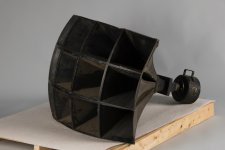 WE model 26A horn with 594A field coil driver loudspeaker used by Leo L. Beranek.jpg133.9 KB · Views: 657
WE model 26A horn with 594A field coil driver loudspeaker used by Leo L. Beranek.jpg133.9 KB · Views: 657 -
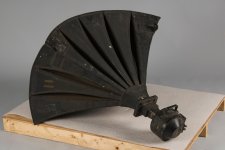 WE model 26A horn with 594A field coil driver loudspeaker used by Leo L. Beranek_2.jpg168.6 KB · Views: 366
WE model 26A horn with 594A field coil driver loudspeaker used by Leo L. Beranek_2.jpg168.6 KB · Views: 366 -
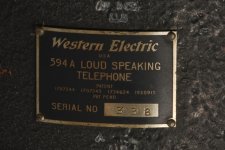 WE model 26A horn with 594A field coil driver loudspeaker used by Leo L. Beranek_3.jpg217.9 KB · Views: 368
WE model 26A horn with 594A field coil driver loudspeaker used by Leo L. Beranek_3.jpg217.9 KB · Views: 368 -
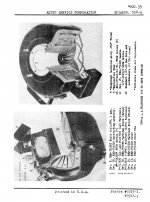 594A from ERPI_Small.jpg275.1 KB · Views: 883
594A from ERPI_Small.jpg275.1 KB · Views: 883 -
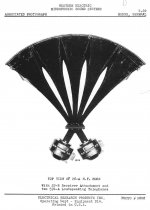 26-A.jpg70.3 KB · Views: 891
26-A.jpg70.3 KB · Views: 891 -
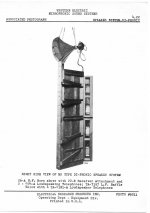 Mirrophonic Speaker System.jpg376.2 KB · Views: 239
Mirrophonic Speaker System.jpg376.2 KB · Views: 239 -
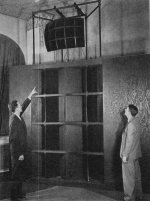 The-WE-Mirrophonic-System-46.jpg141.8 KB · Views: 244
The-WE-Mirrophonic-System-46.jpg141.8 KB · Views: 244
Last edited:
My favourite jazz bar in Tokyo has these monsters. Sound is just sublime. Big influence on my eventually grabbing some Klipsch Fortes.I often look at the Western Electric horns. As a lover of vintage speaker systems, these are discribed as the Nirvana of speakers, an unmatched soundquality coming from a system developed in the '30s.
They are demonstrated often at high end audio shows (Munich Silbatone) with raving reports about sound - realism - dynamics.
And they are sexy as hell with those curves.
Butt...How is all of this possible? A design made in the '30s?
As we want to design a good horn speaker these days, we use computerprograms, we count in directivity - bandwidth - no folds in the hornpath - ... Are the WE horns breaking all of these laws? Or are they just a vintage hype?
See post #21.
It's not the horn, it's the driver. Edge-wound flat aluminum wire. Large spherical dome.
I've always thought tweeter power was underestimated. These have that capability and maybe loud in the treble so elderly ears like the tweeting.
Here's something about those horns from the New York Times that you should put in the folder titled, "There's One Born Every Minute":
https://www.nytimes.com/2022/07/25/style/devon-turnbull-ojas-speakers.html
It's not the horn, it's the driver. Edge-wound flat aluminum wire. Large spherical dome.
I've always thought tweeter power was underestimated. These have that capability and maybe loud in the treble so elderly ears like the tweeting.
Here's something about those horns from the New York Times that you should put in the folder titled, "There's One Born Every Minute":
https://www.nytimes.com/2022/07/25/style/devon-turnbull-ojas-speakers.html
The horn loudspeakers book contains much evidence that WE tried to reduce the cost of their cinema systems (which did not sell very well) as the price was prohibitive. The most interesting application of them for me was that a large system was constructed including 5 bass compression driver horns for the Holywood Bowl and an outdoor concert held, to me its amazing that large scale full range sound reinforcement was possible in the 1930's. The inovation of the 555 is substantial, modern dome type compresion drivers are very simlar in construction.
?? I thought they failed because they had no means to match that 15' time delay to the bass cabinet. The taps from the dancer's shoes didnt line up sonically; the theater owners didnt like it.is excessive beaming and why they failed as cinema systems.
As a kid, I used to be fascinated with the optical audio track on film. One looked like PWM, another looked like an AM modulated carrier. Imagine a projector with one optical pickup for the long horns, another a little bit further downstream for the bottom.
Right, but it was just 'part n' parcel' with trying to blend a multiple horizontal and vertical array of beaming on axis, very narrow polar response horns that was an 'exercise in futility' according to the crusty old EE that had apprenticed at W.E. during this time.
But the 1935 Eleanor Powell (double) tap dancing on a table 8 ft tweeter delay from the two way stage monitor was the 'straw that broke the Camel's back', so MGM 'took the Bull by the horns' and funded a whole new ~ 'cost no object' two horn system, which became the Shearer Two Way Horn System in 1936 that we still pay homage to ~86 yrs later.
But the 1935 Eleanor Powell (double) tap dancing on a table 8 ft tweeter delay from the two way stage monitor was the 'straw that broke the Camel's back', so MGM 'took the Bull by the horns' and funded a whole new ~ 'cost no object' two horn system, which became the Shearer Two Way Horn System in 1936 that we still pay homage to ~86 yrs later.
Looks a bit like your avatar! I wonder if it would have been possible to have the two channel film sound pickup, or, did the technique used at the time obscure it? Maybe they thought of it, but the projector manufacturer said "You want Us to do what?"
Dolby digital sound tracks on 35mm prints did my head in when they first came out. Putting the soundtrack inbetween the sprocket holes appeared to be the daftest idea ever that should never work. At least until I read about the herculean efforts required to stop IMAX projectors tearing the film apart rather than projecting it. Hats off to the ingenuity of Engineers working on cinema.
DLP projectors seem almost low tech in comparion...
DLP projectors seem almost low tech in comparion...
Not even closeLooks a bit like your avatar! I wonder if it would have been possible to have the two channel film sound pickup, or, did the technique used at the time obscure it? Maybe they thought of it, but the projector manufacturer said "You want Us to do what?"
I've been extensively exposed to the video side of these systems, but never had any interest beyond being fascinated by how such a huge/mechanically, electronically complex/expensive they were and now + more of 'everything' can be had in a shoe box size projector.
If still on the net, highly recommend researching all the pictorial, technical info on RCA's discrete (4) channel system for Fantasia, it's mind blowing!
You, uh, actually have a stereo set? I thought I read you have parties where you use them. Is this the Fantasound link?while mine are
http://www.widescreenmuseum.com/sound/fantasound1.htm
That's the original, the way I remember it there were links to lot more info 'breaking down' this 'overview'.
Actually had a derived three channel version with my DIY A7-500 pair initially for the derived rear channels at my first home, though only a single mid bass horn cab/channel, which believe me was quite enough for even my 26 x 46 ft, cathedral ceiling 'great' room.
Right, We had a corner lot at the entrance to a short cul-de-sac, so I'd roll one or two out depending on the size/type of crowd onto the patio up against the house's brick wall to do 'block' parties during school Summer recess months. A great way to break in a new baby to sleep through most anything.
Sadly, the 'few ruined it for the many' when the (can't post in this politically correct, etc., 'climate') from the nearby county 'up the road' kept forcing a shutdown ever sooner with each ensuing event till we all ~ said to heck with it and moved away as the area continued to decline.
Actually had a derived three channel version with my DIY A7-500 pair initially for the derived rear channels at my first home, though only a single mid bass horn cab/channel, which believe me was quite enough for even my 26 x 46 ft, cathedral ceiling 'great' room.
Right, We had a corner lot at the entrance to a short cul-de-sac, so I'd roll one or two out depending on the size/type of crowd onto the patio up against the house's brick wall to do 'block' parties during school Summer recess months. A great way to break in a new baby to sleep through most anything.
Sadly, the 'few ruined it for the many' when the (can't post in this politically correct, etc., 'climate') from the nearby county 'up the road' kept forcing a shutdown ever sooner with each ensuing event till we all ~ said to heck with it and moved away as the area continued to decline.
As someone who spent a stupid amount of time on some vintage JBL horns I'll tell you not to stress over it. I wanted vintage because I wanted vintage and something different. I love making old new again. So ask yourself do you want something different? Also look at Bema and Radian, they make great compression drivers. It's a fun rabbit hole.
Shearer two way horn system download is blank, but shearer horn causes wikipedia to bring up this article about John Kenneth Hilliard: https://en.wikipedia.org/wiki/John_Kenneth_Hilliard
who worked on the Shearer horn at MGM then after the war at Altec Lansing worked on the VOTT
who worked on the Shearer horn at MGM then after the war at Altec Lansing worked on the VOTT
- Home
- Loudspeakers
- Multi-Way
- Thoughts about the Western Electric horns
